TOYOTA MATRIX 2009 E140 / 2.G Owners Manual
Manufacturer: TOYOTA, Model Year: 2009, Model line: MATRIX, Model: TOYOTA MATRIX 2009 E140 / 2.GPages: 440, PDF Size: 9.39 MB
Page 351 of 440

5
When trouble arises
351 5-1. Essential information
Disclosure of the data
Toyota will not disclose the data recorded in an EDR to a third party
except when:
â—ŹAn agreement from the vehicle's owner (or the leasing company for
a leased vehicle) is obtained
â—ŹOfficially requested by the police or other authorities
â—ŹUsed as a defense for Toyota in a law suit
â—ŹOrdered by a court law
However, if necessary Toyota will:
â—ŹUse the data for research on Toyota vehicle safety performance
â—ŹDisclose the data to a third party for research purposes without dis-
closing details of the vehicle owner, and only when it is deemed
necessary
â—ŹDisclose summarized data cleared of vehicle identification informa-
tion to a non-Toyota organization for research purposes
Page 352 of 440
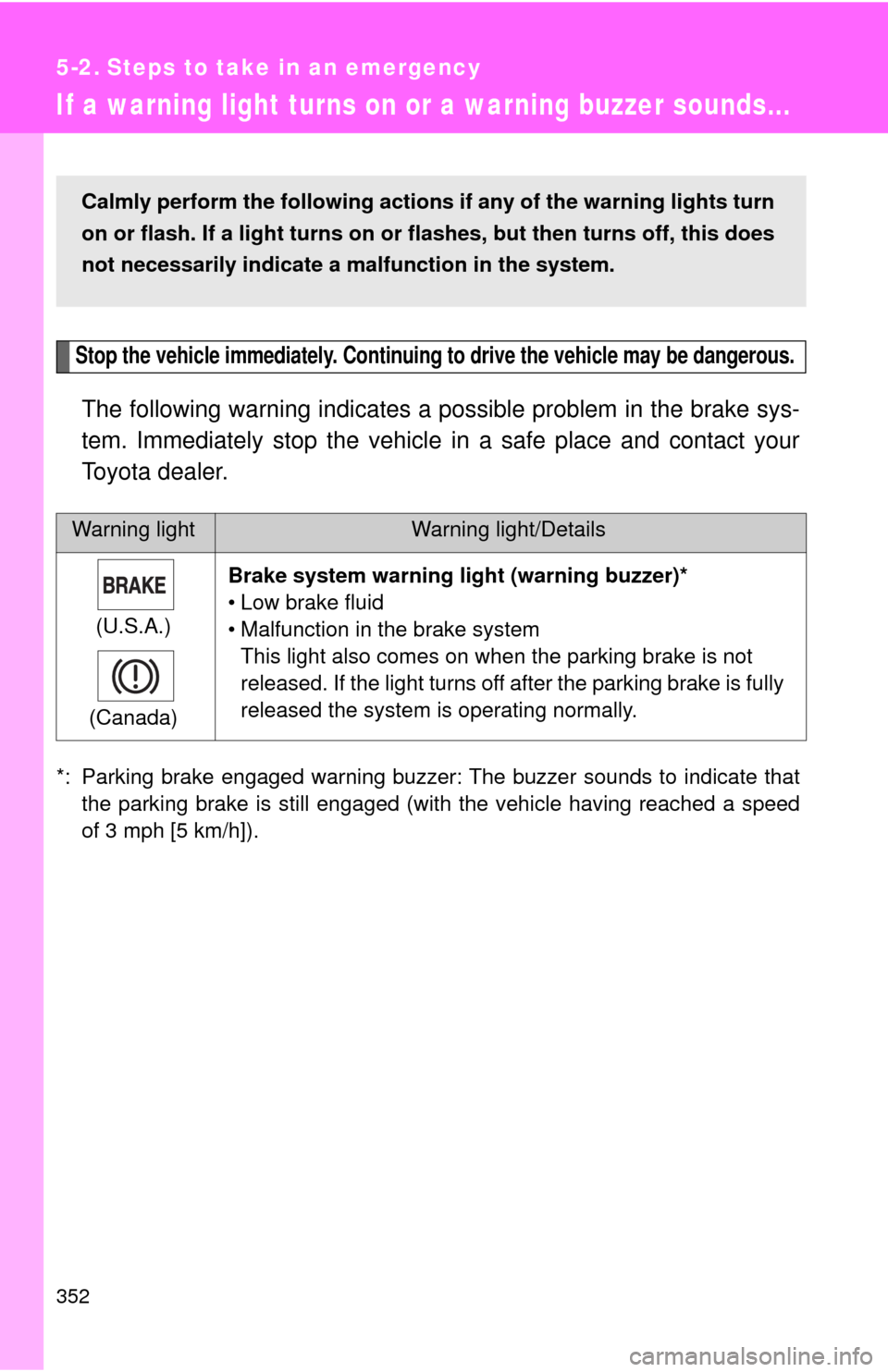
352
5-2. Steps to take in an emergency
If a warning light turns on or a warning buzzer sounds...
Stop the vehicle immediately. Continuing to drive the vehicle may be dangerous.
The following warning indicates a possible problem in the brake sys-
tem. Immediately stop the vehicle in a safe place and contact your
Toyota dealer.
*: Parking brake engaged warning buzzer: The buzzer sounds to indicate that
the parking brake is still engaged (with the vehicle having reached a speed
of 3 mph [5 km/h]).
Warning lightWarning light/Details
(U.S.A.)
(Canada)Brake system warning light (warning buzzer)*
• Low brake fluid
• Malfunction in the brake system
This light also comes on when the parking brake is not
released. If the light turns off after the parking brake is fully
released the system is operating normally.
Calmly perform the following actions if any of the warning lights turn
on or flash. If a light turns on or flashes, but then turns off, this does
not necessarily indicate a malfunction in the system.
Page 353 of 440
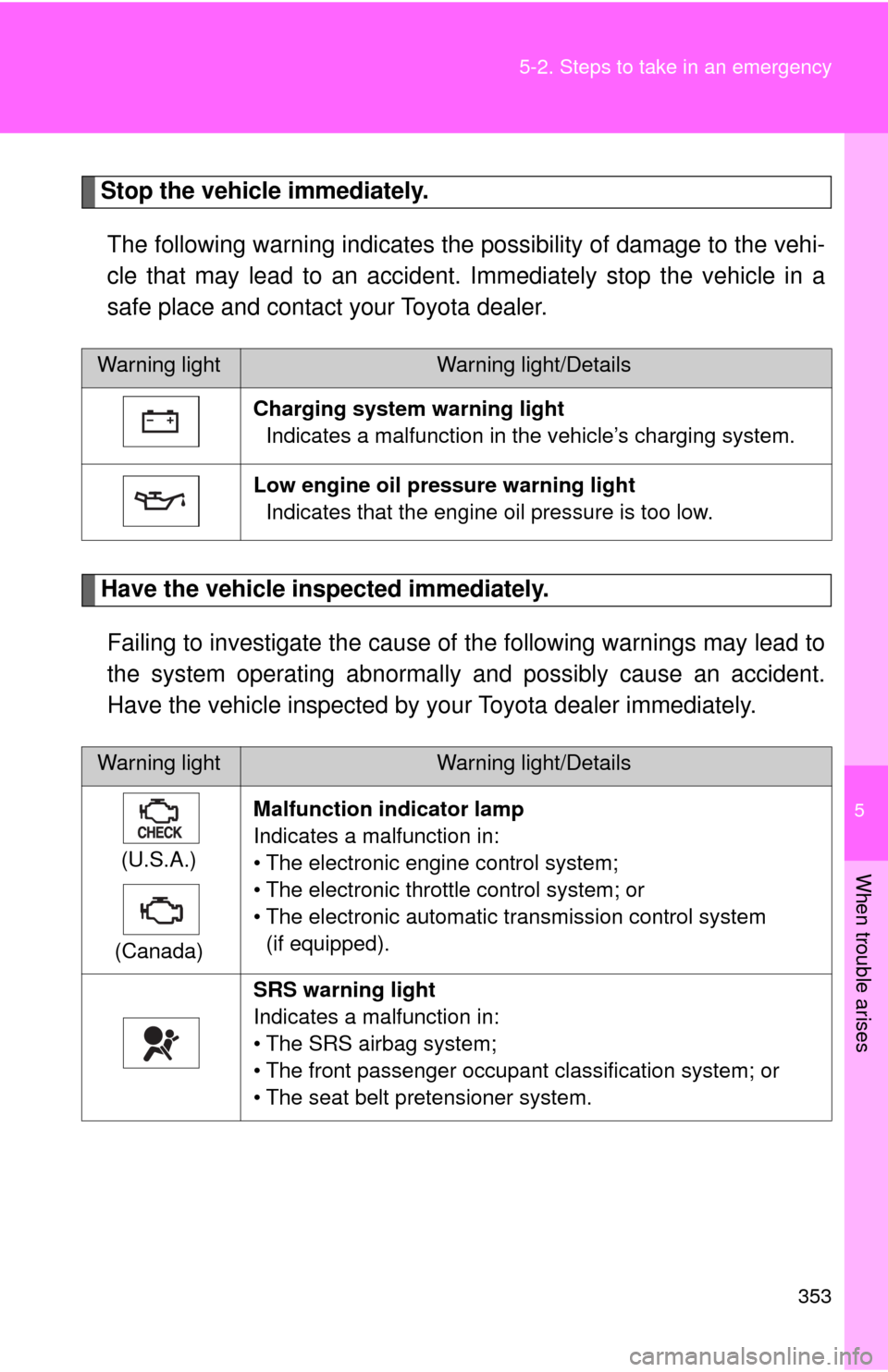
5
When trouble arises
353 5-2. Steps to take in an emergency
Stop the vehicle immediately.
The following warning indicates the possibility of damage to the vehi-
cle that may lead to an accident. Immediately stop the vehicle in a
safe place and contact your Toyota dealer.
Have the vehicle inspected immediately.
Failing to investigate the cause of the following warnings may lead to
the system operating abnormally and possibly cause an accident.
Have the vehicle inspected by your Toyota dealer immediately.
Warning lightWarning light/Details
Charging system warning light
Indicates a malfunction in the vehicle’s charging system.
Low engine oil pressure warning light
Indicates that the engine oil pressure is too low.
Warning lightWarning light/Details
(U.S.A.)
(Canada)Malfunction indicator lamp
Indicates a malfunction in:
• The electronic engine control system;
• The electronic throttle control system; or
• The electronic automatic transmission control system
(if equipped).
SRS warning light
Indicates a malfunction in:
• The SRS airbag system;
• The front passenger occupant classification system; or
• The seat belt pretensioner system.
Page 354 of 440
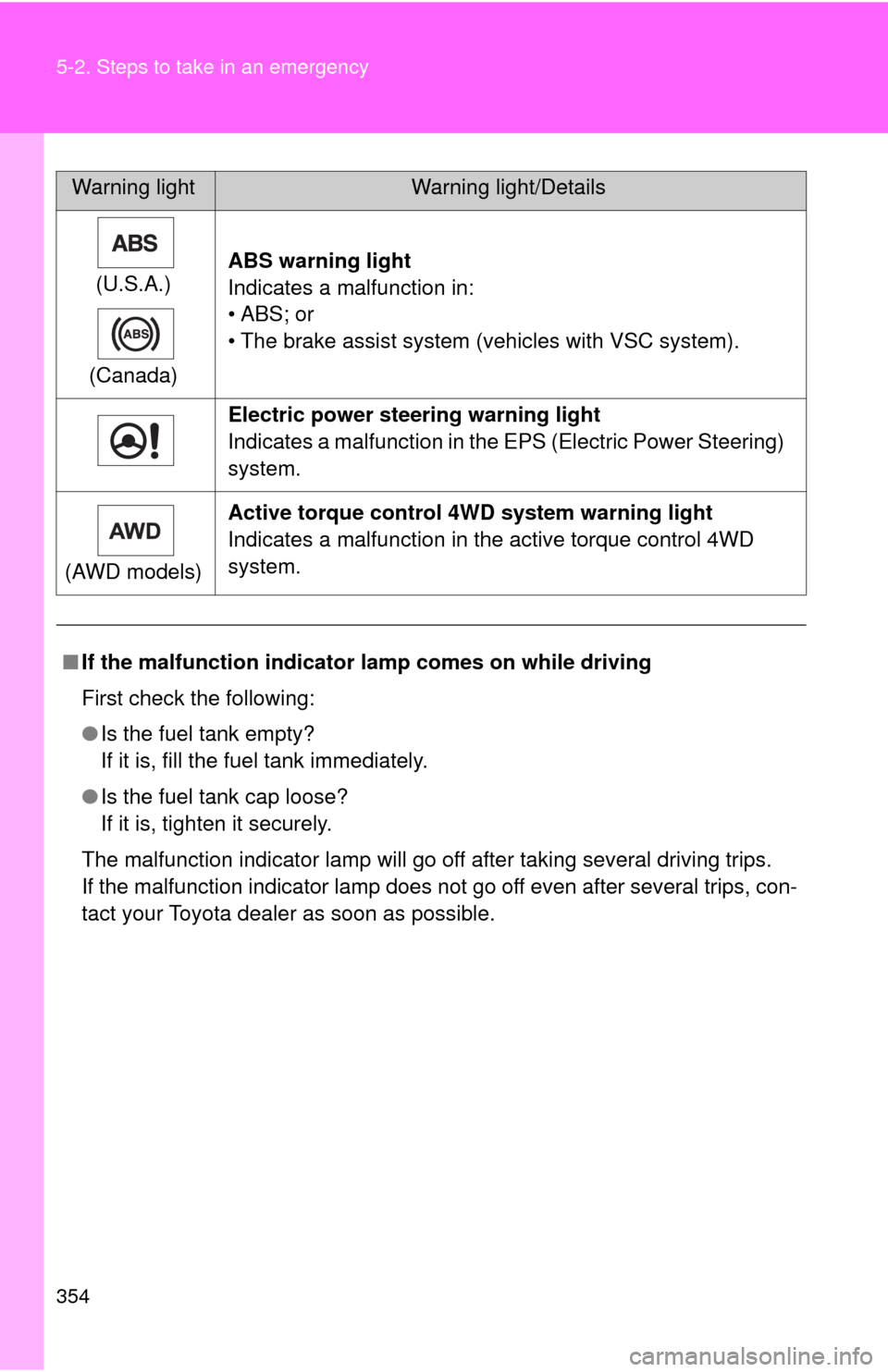
354 5-2. Steps to take in an emergency
(U.S.A.)
(Canada)ABS warning light
Indicates a malfunction in:
•ABS; or
• The brake assist system (vehicles with VSC system).
Electric power steering warning light
Indicates a malfunction in the EPS (Electric Power Steering)
system.
(AWD models)Active torque control 4WD system warning light
Indicates a malfunction in the active torque control 4WD
system.
â– If the malfunction indicator lamp comes on while driving
First check the following:
â—ŹIs the fuel tank empty?
If it is, fill the fuel tank immediately.
â—ŹIs the fuel tank cap loose?
If it is, tighten it securely.
The malfunction indicator lamp will go off after taking several driving trips.
If the malfunction indicator lamp does not go off even after several trips, con-
tact your Toyota dealer as soon as possible.
Warning lightWarning light/Details
Page 355 of 440
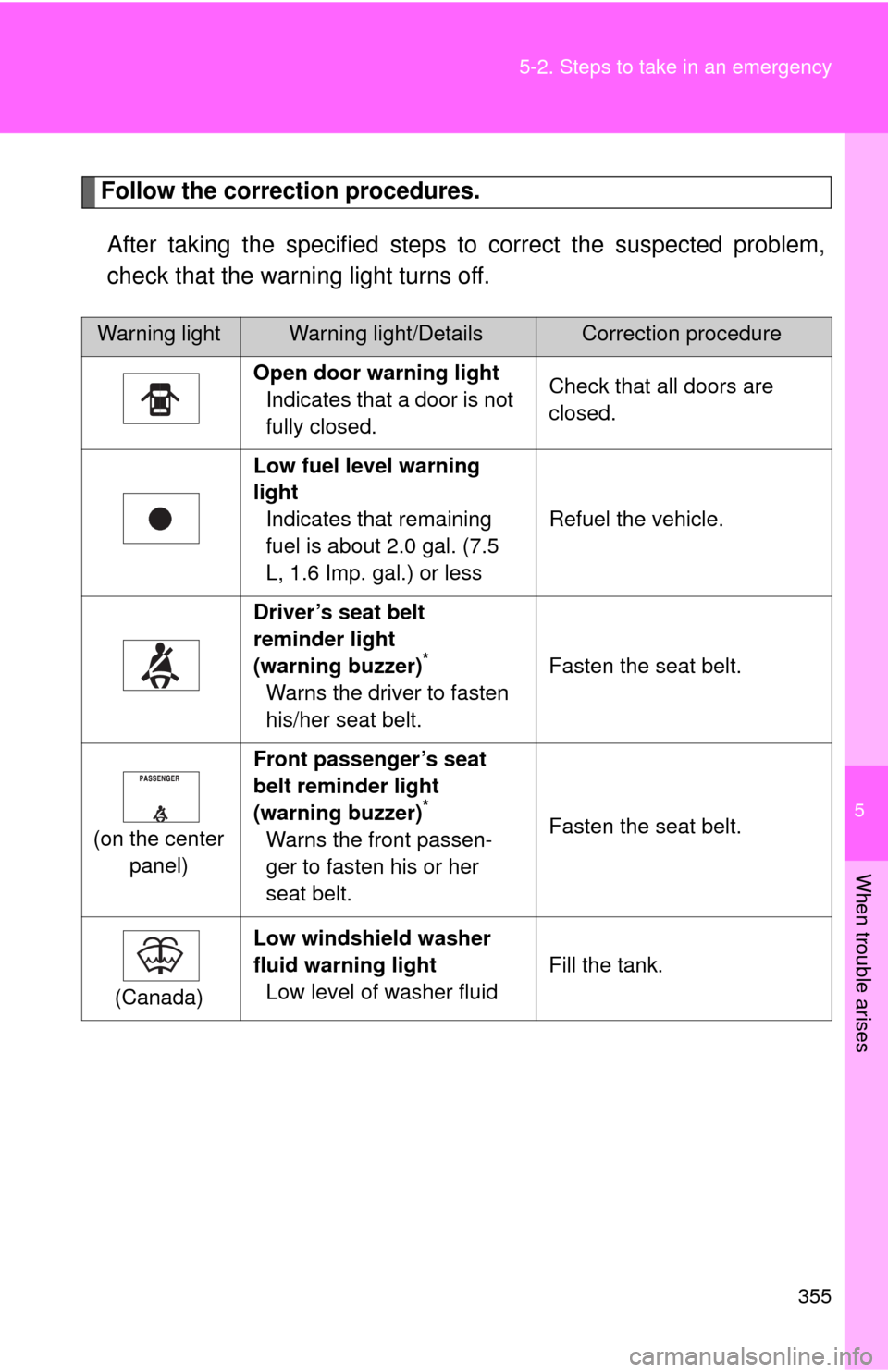
5
When trouble arises
355 5-2. Steps to take in an emergency
Follow the correction procedures.
After taking the specified steps to correct the suspected problem,
check that the warning light turns off.
Warning lightWarning light/DetailsCorrection procedure
Open door warning light
Indicates that a door is not
fully closed.Check that all doors are
closed.
Low fuel level warning
light
Indicates that remaining
fuel is about 2.0 gal. (7.5
L, 1.6 Imp. gal.) or lessRefuel the vehicle.
Driver’s seat belt
reminder light
(warning buzzer)
*
Warns the driver to fasten
his/her seat belt.Fasten the seat belt.
(on the center
panel)Front passenger’s seat
belt reminder light
(warning buzzer)
*
Warns the front passen-
ger to fasten his or her
seat belt.Fasten the seat belt.
(Canada)Low windshield washer
fluid warning light
Low level of washer fluidFill the tank.
Page 356 of 440
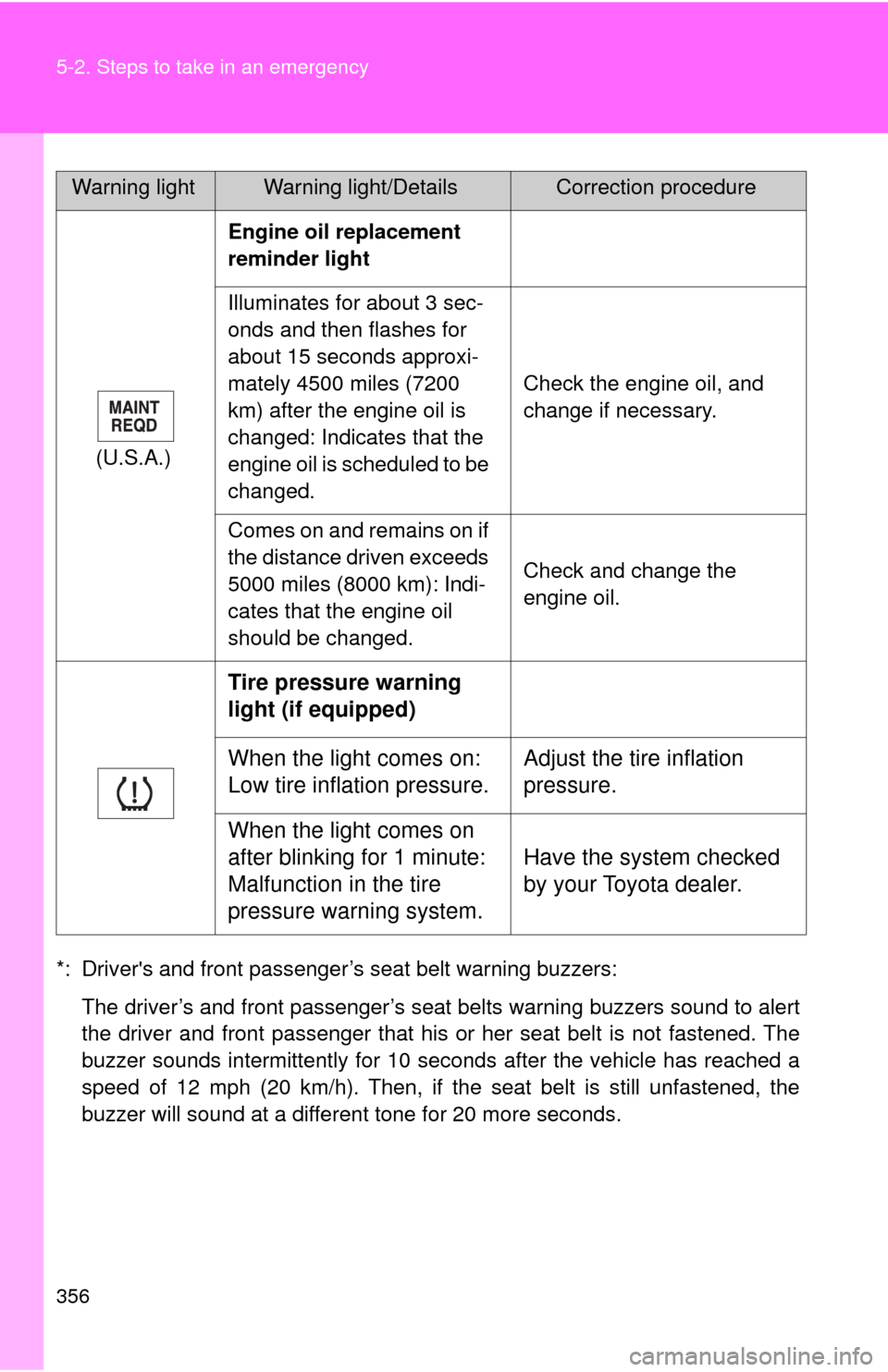
356 5-2. Steps to take in an emergency
*: Driver's and front passenger’s seat belt warning buzzers:
The driver’s and front passenger’s seat belts warning buzzers sound to alert
the driver and front passenger that his or her seat belt is not fastened. The
buzzer sounds intermittently for 10 seconds after the vehicle has reached a
speed of 12 mph (20 km/h). Then, if the seat belt is still unfastened, the
buzzer will sound at a different tone for 20 more seconds.(U.S.A.)Engine oil replacement
reminder light
Illuminates for about 3 sec-
onds and then flashes for
about 15 seconds approxi-
mately 4500 miles (7200
km) after the engine oil is
changed: Indicates that the
engine oil is scheduled to be
changed.Check the engine oil, and
change if necessary.
Comes on and remains on if
the distance driven exceeds
5000 miles (8000 km): Indi-
cates that the engine oil
should be changed.Check and change the
engine oil.
Tire pressure warning
light (if equipped)
When the light comes on:
Low tire inflation pressure.Adjust the tire inflation
pressure.
When the light comes on
after blinking for 1 minute:
Malfunction in the tire
pressure warning system.Have the system checked
by your Toyota dealer.
Warning lightWarning light/DetailsCorrection procedure
Page 357 of 440
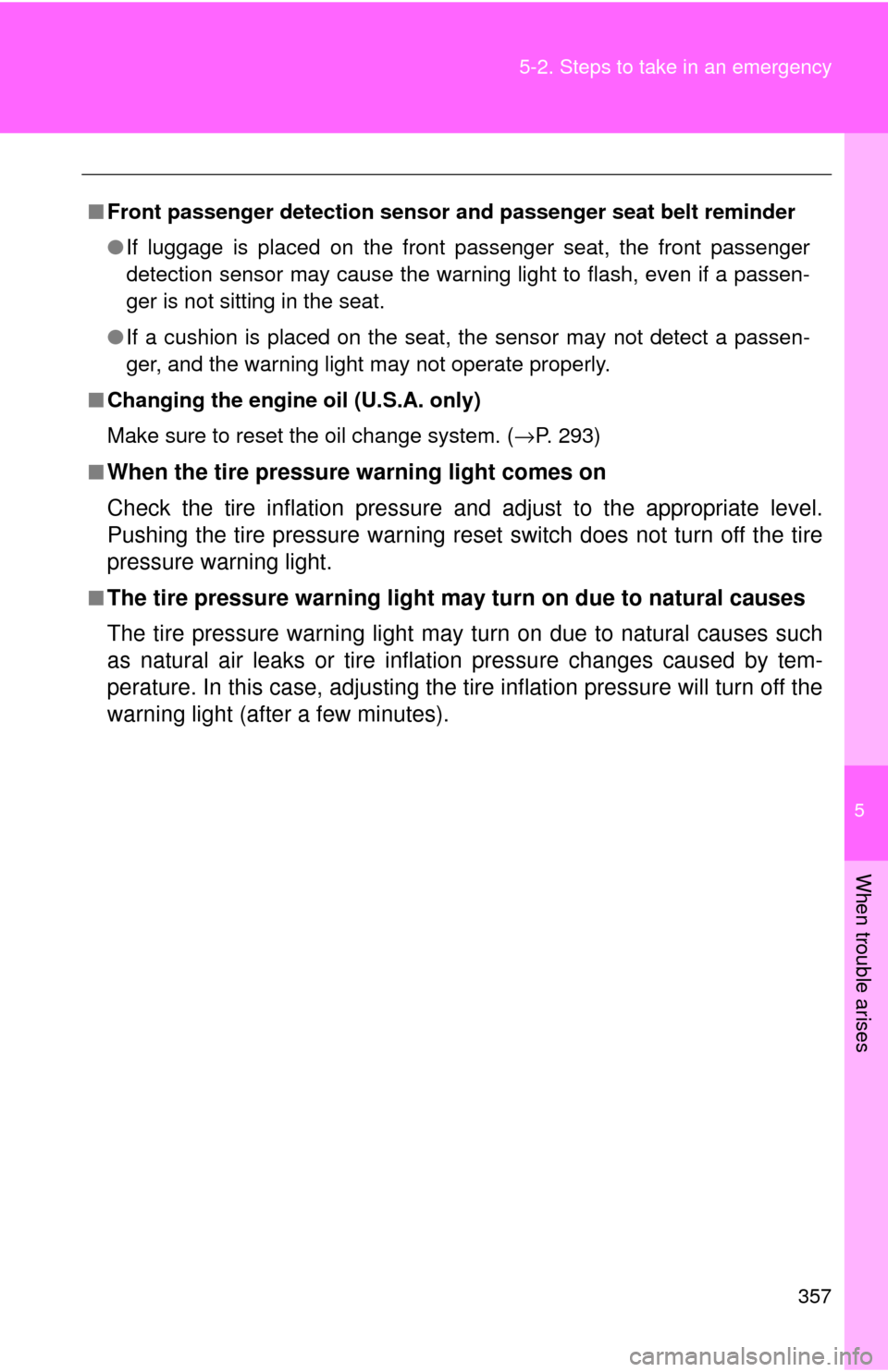
5
When trouble arises
357 5-2. Steps to take in an emergency
â– Front passenger detection sensor and passenger seat belt reminder
â—ŹIf luggage is placed on the front passenger seat, the front passenger
detection sensor may cause the warning light to flash, even if a passen-
ger is not sitting in the seat.
â—ŹIf a cushion is placed on the seat, the sensor may not detect a passen-
ger, and the warning light may not operate properly.
â– Changing the engine oil (U.S.A. only)
Make sure to reset the oil change system. (→P. 293)
â–
When the tire pressure warning light comes on
Check the tire inflation pressure and adjust to the appropriate level.
Pushing the tire pressure warning reset switch does not turn off the tire
pressure warning light.
â– The tire pressure warning light may turn on due to natural causes
The tire pressure warning light may turn on due to natural causes such
as natural air leaks or tire inflation pressure changes caused by tem-
perature. In this case, adjusting the tire inflation pressure will turn off the
warning light (after a few minutes).
Page 358 of 440

358 5-2. Steps to take in an emergency
â– When a tire is replaced with a spare tire
The compact spare tire is not equipped with the tire pressure warning
valve and transmitter. If a tire goes flat, the tire pressure warning light will
not turn off even though the flat tire is replaced with the spare tire.
Replace the spare tire with the repaired tire and adjust the proper tire
inflation pressure. The tire pressure warning light will turn off after a few
minutes.
â– If the tire pressure warning system is inoperative
The tire pressure warning system will be disabled in the following condi-
tions:
(When the condition becomes normal, the system will work properly.)
â—ŹIf tires not equipped with tire pressure warning valves and transmit-
ters are used.
â—ŹIf the ID code on the tire pressure warning valves and transmitters is
not registered in the tire pressure warning computer.
â—ŹIf the tire inflation pressure is 73 psi (500 kPa, 5.1 kgf/cm2 or bar) or
higher.
The tire pressure warning system may be disabled in the following condi-
tions:
(When the condition becomes normal, the system will work properly.)
â—ŹIf electronic devices or facilities using similar radio wave frequencies
are nearby.
â—ŹIf a radio set at similar frequencies is in use in the vehicle.
â—ŹIf a window tint that affects the radio wave signals is installed.
â—ŹIf there is a lot of snow or ice on the vehicle, in particular around the
wheels or wheel housings.
â—ŹIf non-genuine Toyota wheels are used. (Even if you use Toyota
wheels, the tire pressure warning system may not work properly with
some types of tires.)
â—ŹIf tire chains are used.
Page 359 of 440
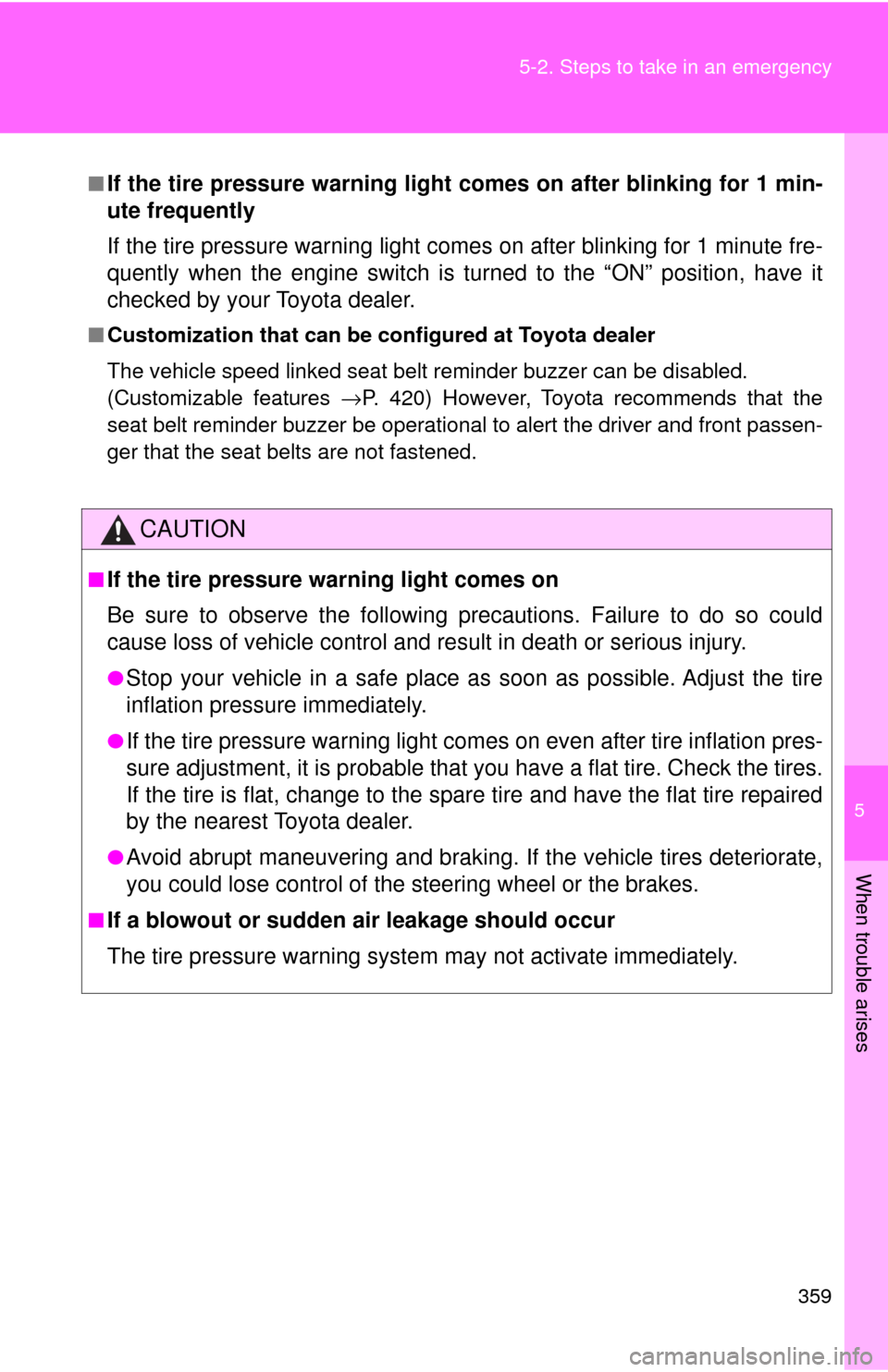
5
When trouble arises
359 5-2. Steps to take in an emergency
â– If the tire pressure warning light comes on after blinking for 1 min-
ute frequently
If the tire pressure warning light comes on after blinking for 1 minute fre-
quently when the engine switch is turned to the “ON” position, have it
checked by your Toyota dealer.
â– Customization that can be configured at Toyota dealer
The vehicle speed linked seat belt reminder buzzer can be disabled.
(Customizable features →P. 420) However, Toyota recommends that the
seat belt reminder buzzer be operational to alert the driver and front passen-
ger that the seat belts are not fastened.
CAUTION
â– If the tire pressure warning light comes on
Be sure to observe the following precautions. Failure to do so could
cause loss of vehicle control and result in death or serious injury.
â—ŹStop your vehicle in a safe place as soon as possible. Adjust the tire
inflation pressure immediately.
â—ŹIf the tire pressure warning light comes on even after tire inflation pres-
sure adjustment, it is probable that you have a flat tire. Check the tires.
If the tire is flat, change to the spare tire and have the flat tire repaired
by the nearest Toyota dealer.
â—ŹAvoid abrupt maneuvering and braking. If the vehicle tires deteriorate,
you could lose control of the steering wheel or the brakes.
â– If a blowout or sudden air leakage should occur
The tire pressure warning system may not activate immediately.
Page 360 of 440
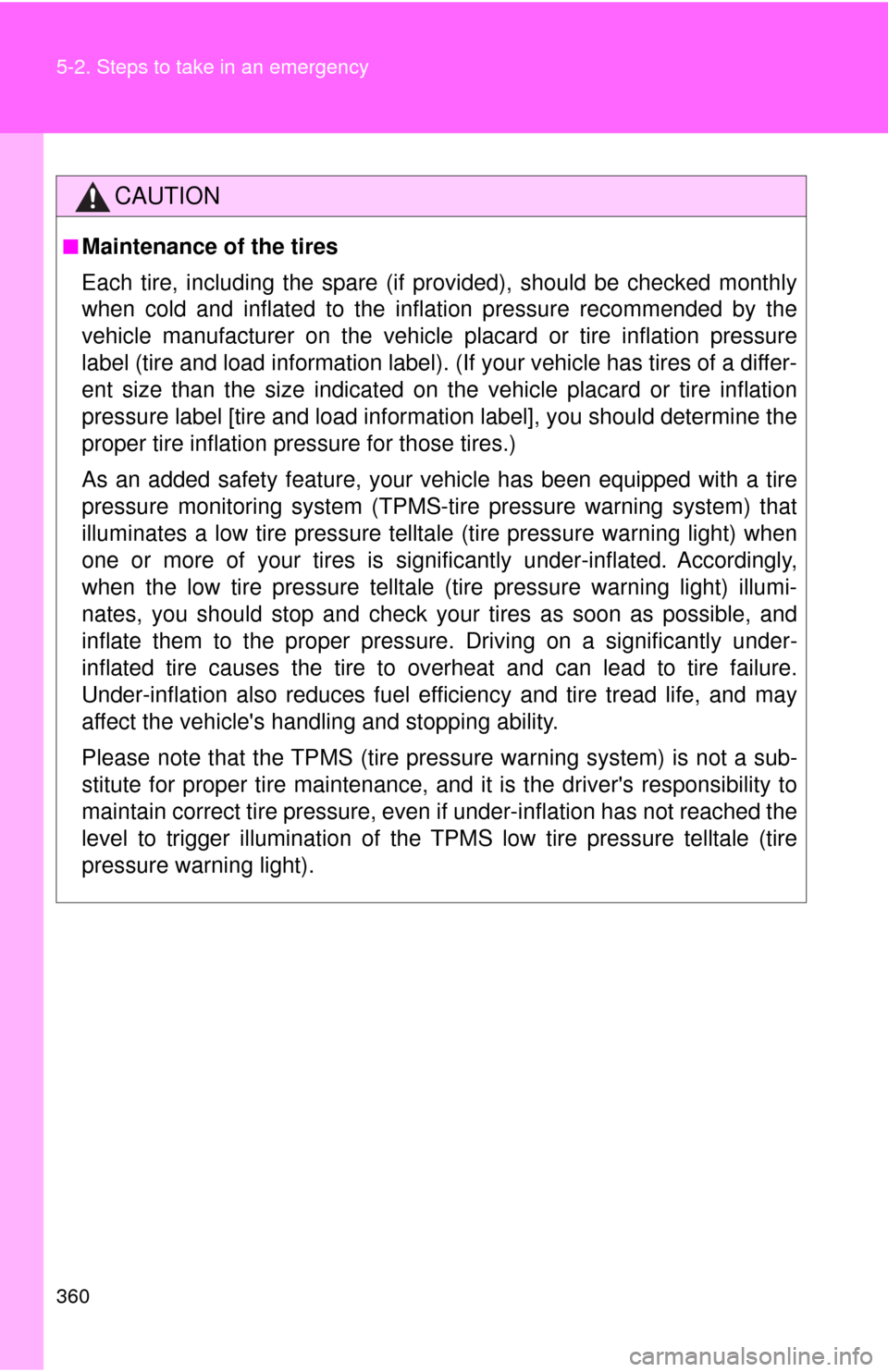
360 5-2. Steps to take in an emergency
CAUTION
â– Maintenance of the tires
Each tire, including the spare (if provided), should be checked monthly
when cold and inflated to the inflation pressure recommended by the
vehicle manufacturer on the vehicle placard or tire inflation pressure
label (tire and load information label). (If your vehicle has tires of a differ-
ent size than the size indicated on the vehicle placard or tire inflation
pressure label [tire and load information label], you should determine the
proper tire inflation pressure for those tires.)
As an added safety feature, your vehicle has been equipped with a tire
pressure monitoring system (TPMS-tire pressure warning system) that
illuminates a low tire pressure telltale (tire pressure warning light) when
one or more of your tires is significantly under-inflated. Accordingly,
when the low tire pressure telltale (tire pressure warning light) illumi-
nates, you should stop and check your tires as soon as possible, and
inflate them to the proper pressure. Driving on a significantly under-
inflated tire causes the tire to overheat and can lead to tire failure.
Under-inflation also reduces fuel efficiency and tire tread life, and may
affect the vehicle's handling and stopping ability.
Please note that the TPMS (tire pressure warning system) is not a sub-
stitute for proper tire maintenance, and it is the driver's responsibility to
maintain correct tire pressure, even if under-inflation has not reached the
level to trigger illumination of the TPMS low tire pressure telltale (tire
pressure warning light).